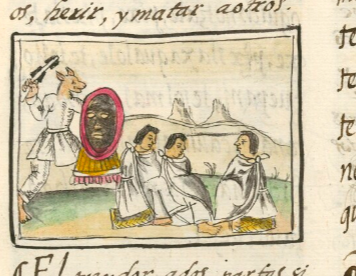teyauh (FCbk10f25v)
This iconographic example, featuring a murderer (teyauh), is included in this digital collection for the purpose of making comparisons with related hieroglyphs. The term selected for this example comes from the keywords chosen by the team behind the Digital Florentine Codex. There is no gloss. This example shows a man with a dog’s head. He is fully dressed in Spanish-style a white cotton, belted tunic and trousers. All of this clothing involves some shading that gives it a three-dimensionality, showing European artistic influence. His body is in a frontal view, but his head (the dog’s head) is in a profile view, turned toward the right. In that direction are three Nahua men wearing the same clothing but with added cloaks (tilmatli), and they are sitting on low woven seats (icpalli). The teyauh is threatening them with an obsidian blade-studded wooden club (macuahuitl), while also holding a large round shield. The shield has a red rim and a large black center with an anthropomorphic face on it. Yellow and red feathers hang down from the lower side of the shield, and they are held together with a white band running horizontally. The text says that this murderer had a dog’s heart and is, in fact, a dog. But this figure with the dog head is also reminiscent of the way Coyotl Inahual has been drawn in other places in Florentine Codex.
Stephanie Wood
Murder is still (September 2025) rare in this digital collection. One killing, which is more of an execution, appears below. See also the man with the coyote head (a nahualli, in that case, at least). The use of a face, often a smiling face on a shield is worth investigating further. Two other examples come from the Codex Vergara (11r and 12v). The Codex Azcatitlan (Library of Congress, Image #30) shows Pedro de Alvarado (“Tonatiuh”) carrying a shield with a face in profile. In the latter, the face of the sun may well be implied, and perhaps these other shields with faces show European influence, given the use of suns as a heraldic charge in medieval and Renaissance art. See, for example, the fifteenth-century Book of Hours in France. Faces on European shields can also represent Christ or saints.
Stephanie Wood
teiaouh
teyauh
Stephanie Wood
1577
Jeff Haskett-Wood
asesino, asesinos, matar, asesinar, guerrero, guerreros, macanas, rodelas, escudos
teyauh, a murderer, a killer, https://nahuatl.wired-humanities.org/content/teyauh
el asesino
Stephanie Wood
Available at Digital Florentine Codex/Códice Florentino Digital, edited by Kim N. Richter and Alicia Maria Houtrouw, "Book 10: The People", fol. 25v, Getty Research Institute, 2023. https://florentinecodex.getty.edu/en/book/10/folio/25v/images/0 Accessed 5 September 2025.
Images of the digitized Florentine Codex are made available under the following Creative Commons license: CC BY-NC-ND (Attribution-NonCommercial-NoDerivs 4.0 International). For print-publication quality photos, please contact the Biblioteca Medicea Laurenziana ([email protected]). The Library of Congress has also published this manuscript, using the images of the World Digital Library copy. “The Library of Congress is unaware of any copyright or other restrictions in the World Digital Library Collection. Absent any such restrictions, these materials are free to use and reuse.”




